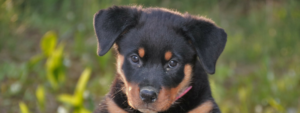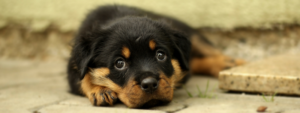Rottweiler Puppy Potty Training Tips

You’ve adopted a new puppy- great! Now, you’re looking to potty train your Rottweiler puppy? Check out this extremely simple guide below; follow these rules, and you’ll have your Rottweiler puppy potty trained in no time!
- Don’t expect your puppy to be able to hold its bladder for hours at a time! Set a schedule, allowing for multiple potty breaks during the day. Again, make sure this schedule is consistent; try not to alter it.
- Don’t meet accidents with aggression or scorn. This can create a sense of fear associated with the whole training process; certainly not what you want.
Useless Corrections
Don’t bother correcting mistakes hours after they happen. Sure, your dog may look guilty, but that almost certainly has to do with him interpreting your visual cues (master is upset) than feeling guilty themselves.
Your Rottweiler puppy isn’t going to understand why you are upset; you can’t expect a correction to bear any meaning at this point. If anything, you are promoting separation anxiety while you are away.
After all, how would you feel with the knowledge your mother or father will come home in a few hours, in a fit of rage? You either wouldn’t want them to leave or wouldn’t want to be home when they come back. Of course, that is a human interpretation of a dog’s emotions, but the point is the same.
Rottweiler Puppies Need Consistent Repetition
Dog training involves conditioning, or rather- that’s all it is. How do you best condition a behavior? You do it through consistent repetition! Repeat the same training methods (assuming they are correct) every single time!
If you are going to reward once, reward always. Changing up your training style could cause confusion, prolonging the process.
- The ‘Clicker’ is a fantastic device, originally intended for use with dolphin training. These clickers ‘bridge the gap’ between a behavior and the few seconds it to reward that behavior. There is no opportunity for unwanted associations to be made.
Reward Desired Behavior (Let the puppy potty where he or she is supposed to. 🙂
If your Rottweiler puppy eliminates outdoors (while you are, hopefully, with him) offer immediate praise (a treat would be a good idea, too). Your pup just did one of the best things in the world, make them feel that way- show it! Be overly dramatic!
If your pup has an accident indoors, on the other hand, offer nothing but a rush outside. Soon, your Rottweiler puppy will make the connection- ‘My owner is happy, it’s a good thing when I go outside. It’s bad when I go inside; I would much rather go outside!”
- Consider leashing your puppy at all times during these first few weeks. Offer constant supervision; this way, not only will you catch every accident, your pup will always be safe and secure by your side!
Diligent Supervision
Constant supervision is extremely important! You don’t want to miss any accidents; missing an accident/ failing to catch one will set your training process back.
Even more importantly, this will keep your puppy safe. Your little fur-child is like an infant; accidents at that stage could prove lethal.
- I know of an owner who left for work; he came home to find his new puppy suffocated inside a potato chip bag. If he would have crated the pup, it would be alive today.
- If you can’t supervise your pup, consider crating him.
Crate Training: A Solution For Potty Training Cute Puppy Rottweilers

First of all, understand- Crate Training isn’t Cruel! Rather- this could actually save your puppy’s life. Despite what you may have heard, both veterinarians and breeders recommend the use of crates from a young age!
- The original purpose of the Crate was to augment Puppy Training.
- Don’t use a crate as a punishment! Your goal should be for your pup to relate positive experiences with the crate.
For millennia, wild dogs/ wolves have sought out small ‘dens’ where they both can feel a sense of safety and shelter while resting, caring for puppies, or recovering from injuries. If done properly, your crate will turn into your puppies’ very own ‘getaway’, his escape! He will grow to enjoy his crate, often entering on his own.
Wondering where to start? To make this process easier, you can:
- Feed your pup in his crate. This will help him form desirable relations.
- Line the bottom of your crate with soft, cushioned material.
- Leave a chew toy or two your pet enjoys inside the crate.
- There is a difference between 90% enclosed ‘transport’ crates and everyday home crates; try to ensure your dog has a complete view of his surroundings.
- Place the crate in a room your pup is familiar with and enjoys.
Steady Familiarization
Many owners have crated their pup, gone to work, and arrived home to find the nice blanket shredded into confetti; some dogs get so anxious they actually injure themselves trying to chew through metal bars. Separation anxiety can be a problem but is easily avoided with a little bit of effort and proper training.
Don’t leave your puppy in their crate for long hours right off the bat, but start small. Start out with maybe 10 minutes while you are in the room, then 15 minutes, etc. Slowly move up to hours at a time.
Dogs become anxious because they think you left them, and won’t be coming back. If you let them adjust to the situation, and build up their confidence and reassurance that you are coming back, every single time, separation anxiety can usually be avoided.
If you absolutely must leave for work but still want to adopt, consider adopting before a vacation or Friday. Come Monday, ask a neighbor or friend to come and check up on your dog a couple of times while you are away.
- Don’t call home and talk to your dog over the answering machine; that only serves to increase anxiety.
- Don’t lavish your Rottweiler puppy with attention upon leaving or arriving home; rather, act like nothing out of the ordinary happened.
